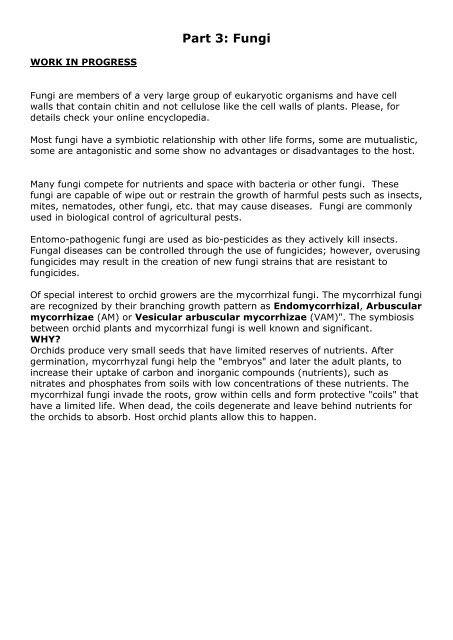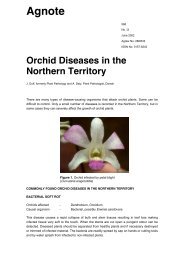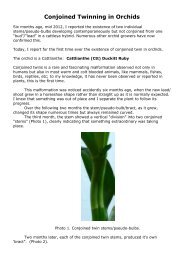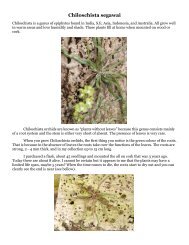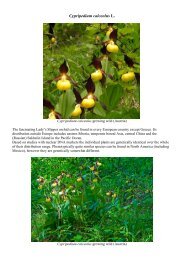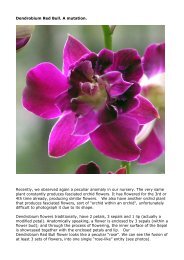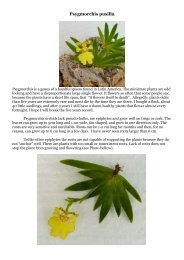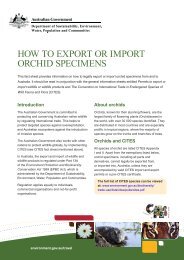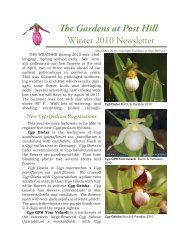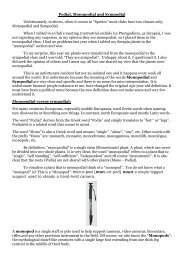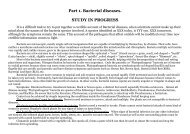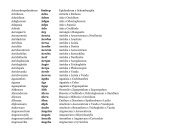Part 3: Fungi - Orchids-World
Part 3: Fungi - Orchids-World
Part 3: Fungi - Orchids-World
You also want an ePaper? Increase the reach of your titles
YUMPU automatically turns print PDFs into web optimized ePapers that Google loves.
<strong>Part</strong> 3: <strong>Fungi</strong><br />
WORK IN PROGRESS<br />
<strong>Fungi</strong> are members of a very large group of eukaryotic organisms and have cell<br />
walls that contain chitin and not cellulose like the cell walls of plants. Please, for<br />
details check your online encyclopedia.<br />
Most fungi have a symbiotic relationship with other life forms, some are mutualistic,<br />
some are antagonistic and some show no advantages or disadvantages to the host.<br />
Many fungi compete for nutrients and space with bacteria or other fungi. These<br />
fungi are capable of wipe out or restrain the growth of harmful pests such as insects,<br />
mites, nematodes, other fungi, etc. that may cause diseases. <strong>Fungi</strong> are commonly<br />
used in biological control of agricultural pests.<br />
Entomo-pathogenic fungi are used as bio-pesticides as they actively kill insects.<br />
Fungal diseases can be controlled through the use of fungicides; however, overusing<br />
fungicides may result in the creation of new fungi strains that are resistant to<br />
fungicides.<br />
Of special interest to orchid growers are the mycorrhizal fungi. The mycorrhizal fungi<br />
are recognized by their branching growth pattern as Endomycorrhizal, Arbuscular<br />
mycorrhizae (AM) or Vesicular arbuscular mycorrhizae (VAM)". The symbiosis<br />
between orchid plants and mycorrhizal fungi is well known and significant.<br />
WHY?<br />
<strong>Orchids</strong> produce very small seeds that have limited reserves of nutrients. After<br />
germination, mycorrhyzal fungi help the "embryos" and later the adult plants, to<br />
increase their uptake of carbon and inorganic compounds (nutrients), such as<br />
nitrates and phosphates from soils with low concentrations of these nutrients. The<br />
mycorrhizal fungi invade the roots, grow within cells and form protective "coils" that<br />
have a limited life. When dead, the coils degenerate and leave behind nutrients for<br />
the orchids to absorb. Host orchid plants allow this to happen.
Table 1: The Best known <strong>Fungi</strong> that cause fungal diseases on orchids.<br />
Aecidium graebnerianum<br />
Alternaria spp.<br />
Bloom Shoot Necrosis; Blossom Flecks;<br />
Bipolaris setariae<br />
Blossom Flecks<br />
Bipolaris sorokiniana<br />
Blossom Flecks<br />
Bipolaris spp<br />
Blossom Flecks<br />
Botryodiplodia oncidii<br />
Dieback<br />
Botryotinia fuckeliana<br />
Gray Mold<br />
Floral Spot; Floral Blight; Petal Blight;<br />
Botrytis cinerea<br />
Soft Rot;<br />
Capnodium citri<br />
Sooty Mold<br />
Cephaleuros virescens<br />
Algal Spot<br />
Cercospora angreci<br />
Leaf Spot<br />
Cercospora cypripedii<br />
Fungal Leaf Spot<br />
Cercospora dendrobii<br />
Fungal Leaf Spot<br />
Cercospora epipactitis<br />
Fungal Leaf Spot<br />
Cercospora odontoglossi<br />
Fungal Leaf Spot<br />
Cercospora peristeriae<br />
Fungal Leaf Spot<br />
Chaetodiplodia sp.<br />
Leaf Spot<br />
Colletotrichum bletae<br />
Anthracnose (Bletia)<br />
Colletotrichum coccodes<br />
Anthracnose<br />
Colletotrichum crassipes<br />
Anthracnose<br />
Colletotrichum dicheae<br />
Anthracnose<br />
Colletotrichum gloeosporioides<br />
Anthracnose<br />
Colletotrichum orchidearum<br />
Anthracnose<br />
Colletotrichum roseolum<br />
Anthracnose (Bletia)<br />
Coniothyrium sp.<br />
Leaf Spot<br />
Corynespora cassiicola<br />
Leaf Spot<br />
Curvularia sp.<br />
Leaf Necrosis<br />
Diplodia bulbicola<br />
Leaf Spot<br />
Diplodia laelio-cattleyae<br />
Leaf Spot; Stem decay;<br />
Diplodia paraphysaria<br />
Leaf Spot<br />
Diplodia sobrali<br />
Leaf Spot<br />
Fusarium cattleyae<br />
Fusarium Wilt<br />
Fusarium moniliforme<br />
Soft Rot;<br />
Fusarium oxysporum<br />
Pseudobulb Rot; Root Rot<br />
Fusarium oxysporum f. Sp. Cattleyae Pseudobulb Rot; Root Rot<br />
Gloeodes pomigena<br />
Sooty Blotch<br />
Gloeosporium affine<br />
Anthracnose European<br />
Gloeosporium cattleyae<br />
Anthracnose<br />
Gloeosporium epidendrii<br />
Anthracnose<br />
Gloeosporium laeliae<br />
Anthracnose<br />
Gloeosporium oncidii<br />
Anthracnose<br />
Gloeosporium pallidum<br />
Anthracnose<br />
Gloeosporium stanhopeae<br />
Anthracnose<br />
Gloesporioides<br />
Anthracnose<br />
Glomerella cincta<br />
Leaf Die-Back (American Anthracnose)
Glomerella cingulata<br />
Guignardia spp.<br />
Hemileia oncidii<br />
Lasiodiplodia theobromae<br />
Macrophoma cattleyicola<br />
Macrophoma oncidii<br />
Nectria behnickiana<br />
Nectria bolbophyli<br />
Nectria bulbicola<br />
Phoma spp.<br />
Phyllosticta capitalensis<br />
Phyllosticta pyriformis<br />
Phyllostictina pyriformis<br />
Physalospora cattleyae<br />
Physalospora orchidearum<br />
Phytophthora cactorum<br />
Phytophthora cinnamomi<br />
Phytophthora nicotianae<br />
Phytophthora palmivora<br />
Pleospora orchidearum<br />
Pseudocercospora spp.<br />
Puccinia cypripedii<br />
Pythium splendens<br />
Pythium ultimum<br />
Rhizoctonia solani<br />
Schizothyrium perexiguum<br />
Schizothyrium pomi<br />
Sclerotinia fuckeliana<br />
Sclerotium orchidearum<br />
Sclerotium rolfsii<br />
Septoria selenophomoides<br />
Sphenospora kevorkianii<br />
Sphenospora mera<br />
Sphenospora saphena<br />
Stibella bulbicola<br />
Tubercularia cattleyicola<br />
Uredo behnickiana<br />
Uredo epidendri<br />
Uredo guacae<br />
Uredo nigropuncta<br />
Volutella albido-pila<br />
Volutella Concentrica<br />
Volutella pachysandra<br />
Zythia nepenthis<br />
Anthracnose<br />
Leaf Spot<br />
Rust<br />
Leaf blight<br />
Leaf<br />
Fungal<br />
Fungal<br />
Fungal<br />
Dry Rot<br />
Leaf Spot; Leaf Lesions; Chlorotic spots<br />
Yellow Leaf Spot<br />
Fungal Leaf Spot<br />
Anthracnose; Fungal Leaf Spot<br />
Anthracnose<br />
Black Rot; Leaf Rot; Crown Rot;<br />
Leaf & Pseudobulb Rot; Stem & Root<br />
Rot<br />
Leaf & Pseudobulb Rot; Stem & Root<br />
Rot<br />
Root Rot; Black Rot;<br />
Fungal<br />
Leaf & Heart Rot<br />
Black Rot; Leaf Rot; Crown Rot;<br />
Root Rot; Stem Rot<br />
Flyspeck<br />
Flyspeck<br />
Petal Blight<br />
Fungal<br />
Leaf Rot; Basal Rot; Stem Rot;<br />
Southern Blight;<br />
Leaf Spot; Stem Decay;<br />
Rust<br />
Rust<br />
Rust<br />
Rust<br />
Rust<br />
Rust<br />
Rust<br />
Fungal Stem Decay;<br />
Leaf Spot<br />
Volutella Blight


